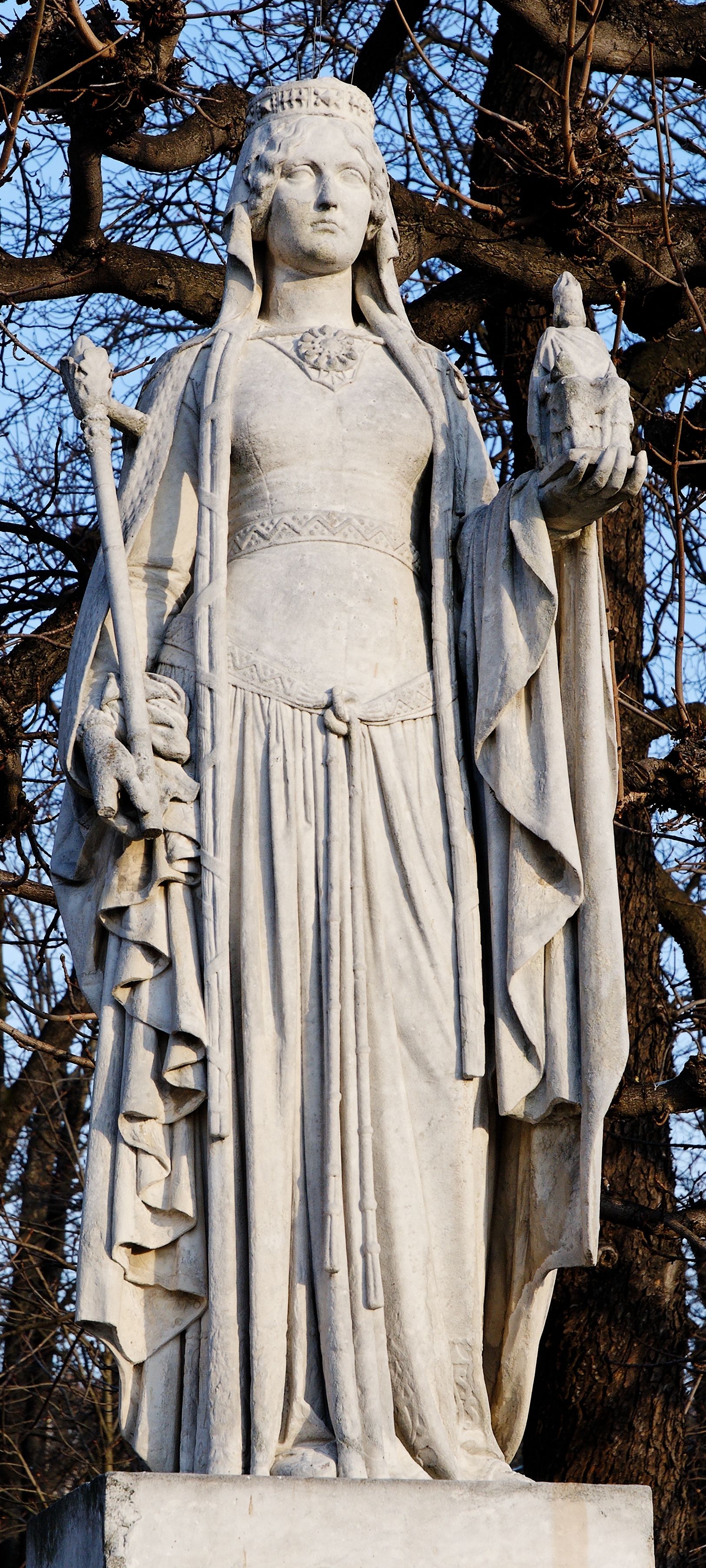Bertrada of Laon, first introduced
here, was the wife of Pepin the Short and mother of Charles (later Charlemagne) and Carloman.* She was not a passive wife and queen. Her relationship with Pepin started while he was still married. She accompanied him on military campaigns. After his death, she stayed involved in the kingdom through her sons.
Her sons did not always see eye-to-eye. Each had half their father's kingdom, but they were supposed to share the part of Aquitaine that Pepin had conquered. When Pepin's death motivated the Aquitainians to rebel, Charlemagne led an army to subdue it. Carloman likewise marched in with an army; the two joined up at Moncontour, where the brothers quarreled and Carloman took his army and went home. Some historians think Carloman was hoping to see Charlemagne's power appear unequal to the task of ruling. Charlemagne succeeded in putting down the rebellion, however, and Carloman simply looked petty and unpatriotic.
Although Bertrada was living at Aachen with Charlemagne—and would for most of her widowhood—she is credited with trying to reconcile the two after their falling out. In light of later events, however, I wonder at her motivations. Her efforts in supporting Charlemagne often seemed to be to the detriment of her younger son.
For instance, she persuaded Charlemagne to marry Desiderata, daughter of King Desiderius of Lombardy. The Franks had fought the Lombards on the pope's behalf in
the past, so this was an unusual move. The result, however, was an alliance between Charlemagne and an enemy who would no longer give him trouble. Apparently Carloman tried to warn the pope of the dangers of this alliance, but Bertrada had convinced Desiderius to give up some territories that were of interest to the papacy. The pope was persuaded to bless the union of his friend with his enemy.
 |
| Family Tree; "Carolus magnus" is in the lower left |
In 770 Bertrada visited Carloman at his headquarters in Seltz (a little northwest of Baden-Baden). It was a unique visit for her, and we don't know what her purpose was: maybe to soothe his hurt feelings, maybe to explain to him her vision for the kingdom, which seemed to be centered on Charlemagne. She also traveled to Bavaria in 770, to speak to Duke Tassilo. Tassilo was a nephew of Pepin the Short, and Bertrada was probably relying on the alliance between the Bavarians and Lombards to ensure the support of the Lombards for Charlemagne.
Not only did this marriage create an alliance between Charlemagne and the enemies
of the pope, but also meant Carloman's territory had Charlemagne on his
western side and a traditional enemy in the Lombards on the
eastern. Carloman was isolated now, but his discomfort would not last long. Carloman died suddenly in 771;
very suddenly, but no chroniclers at the time hint at foul play (of course, the chroniclers at the time were fans of Charlemagne). His widow expected their son Pepin to inherit, but her husband's advisers all turned against this plan and asked Charlemagne to reunite the kingdoms. It was only after Carloman's death and Charlemagne's assumption of power over the whole kingdom that Bertrada left her son's side and retired to the Abbey of Choisy sur Aisne. She died in 783; Charlemagne buried her with honors in
St.-Denis.
One final note. Bertrada had a nickname:
Regina pede aucae (queen with a goose foot). In English, she was called Bertha Broadfoot. No doubt she had large feet, and perhaps walked a little oddly. Some (pseudo-)historians have decided to make a connection between her and the character of "Mother Goose." The earliest reference we have to such a figure is from 1650 and a reference in French to something "like a mother goose story." As I explained in the case of the rhyme "
Ring around the rosy" however, such tenuous connections ought never to be made.
Okay, one
more final note on the relationship between Charles and Carloman: Charles named his eldest son "Carloman" as, we would assume, a tribute to his brother. This boy was named King of Italy and took the Iron Crown of Lombardy in 781, but there is no King Carloman of Italy in the records. Why? Because in that same ceremony, Charlemagne re-named his son "Pippin," wiping out the tribute to his now-long-dead brother. Ouch.
*
There was a third child who lived to adulthood, Gisela (757-810), who became a nun and then abbess at Chelles Abbey.











